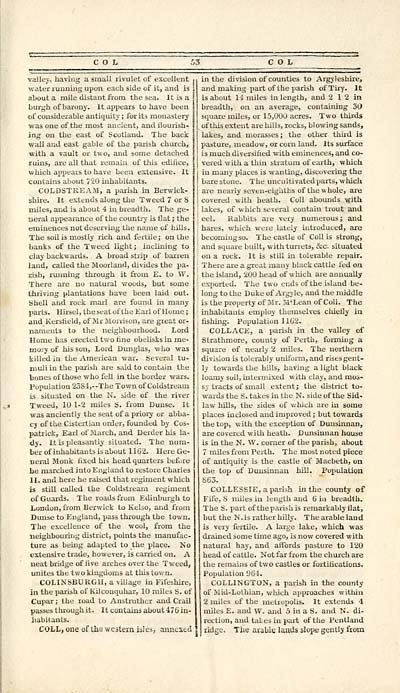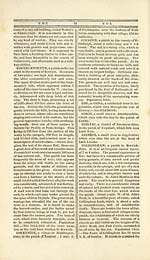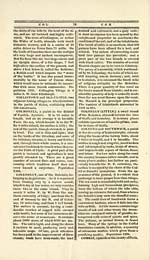Gazetteer of Scotland
(55) Page 53 - COL
Download files
Complete book:
Individual page:
Thumbnail gallery: Grid view | List view

.•alley: having
rivulet of excellent
water running upon each side of it, and is
about a mile distant from the sea. It is a
burgh of barony. It appears to have been
of considerable antiquity; for its monastery-
was one of the most ancient, and flourish-
ing on the east of Scotland. The back
wall and east gable of the parish church,
with a vault or two, and some detached
ruins, are all that remain of this edifice,
which appears to have been extensive. It
contains about 720 inhabitants.
COLDSTREAM, a parish in Berwick-
shire. It extends along the Tweed 7 or S
miles, and is about 4 in breadth. The ge-
neral appearance of the country is flat ; the
eminences not deserving the name of hills.
The soil is mostly rich and fertile; on the
banks of the Tweed light; inclining to
clay backwards. A broad strip of barren
land, called the Moorland, divides the pa-
rish, running through it from K. to YV.
There are no natural woods, but some
thriving plantations have been laid out.
Shell and rock marl are found in many
parts. Hirsel, the seat of the Earl of Home;
and Kersfield, of Mr Morrison, are great or-
naments to the neighbourhood. Lord
Home has erected two tine obelisks in me-
mory of his son, Lord Dunglas, who was
killed in the American war. Several tu-
muli in the parish are said to contain the
bones of those who fell in the border wars.
Population 25S4,--The Town of Coldstream
is situated on the N. side of the river
Tweed, 10 1-2 miles S. from Dunse. It
was anciently the seat of a priory or abba-
cy of the Cistertian order, founded by Cos-
patrick, Earl of March, and Derder his la-
dy. It is pleasantly situated. The num-
ber of inhabitants is about 1162. Here Ge-
neral Monk fixed his headquarters before
he marched into England to restore Charles
II. and here he raised that regiment which
is still called the Coldstream regiment
of Guards. The roads from Edinburgh to
London, from Berwick to Kelso, and from
Dunse to England, pass through the town.
The excellence of the wool, from the
neighbouring district, points the manufac-
ture as being adapted to the place. No
extensive trade, however, is carried on. A
neat bridge of live arches over the Tweed,
unites the two kingdoms at this town.
COLIXSBURGH, a village in Fifeshire,
in the parish of Kilconquhar, 10 miles S. of
Cupar ; the load to Anstruthcr and Cra:
passes through it. It contains about 476 it
habitants.
COLL, one of thewcstern isles, annexed
C O L
m the division of counties to Argyleshire,
and making part of the parish ofTiry. It
is about 14 miles in length, and 2 1 2 in
breadth, on an average, containing 50
square miles, or 15,000 acres. Two thirds
of this extent are hills, rocks, blowing sands,
lakes, and morasses; the other third is
pasture, meadow, or corn land. Its surface
is much diversified with eminences, and co-
vered with a thin stratum of earth, which
in many places is wanting, discovering the
bare stone. The uncultivated parts, which
are nearly seven-eighths of the whole, are
covered with heath. Coll abounds with
lakes, of which several contain trout and
eel. Babbits are very numerous; and
hares, which were lately introduced, are
becomingso. The castle of Coll is strong,
and square built, with turrets, Say. situated
on a rock. It is still in tolerable repair.
There are a great many black cattle fed on
, the island, 200 head of which are annually
exported. The two ends of the island be-
long to the Duke of Argyle, and the middle
is the property of Mr. M'Lean of Coll. The
inhabitants employ themselves chiefly in
fishing. Population 1162.
COLLACE, a parish in the valley of
Strathmore, county of Perth, forming a
square of nearly 2 miles. The northern
division is tolerably uniform, and rises gent-
ly towards the hills, having a light black
loamy soil, intermixed with clay, and mos-
sy tracts of small extent ; the district to-
wards the S. takes in the N. side of the Sid-
law hills, the sides of which are in some
places inclosed and improved ; but towards
the top, with the exception of Dunsinnan,
are covered with heath. Dunsinnan house
is in the N. W. comer of the parish, about
7 miles from Perth. The most noted piece
of antiquity is the castle of Macbeth, on
the top of Dunsinnan hill. Population
S63.
COLLESSIE, a parish in the county of
Fife, S miles in length and 6 in breadth.
The S. part of the parish is remarkably flat,
but the N.is rather hilly. The arable land
is very fertile. A large lake, which was
drained some time ago, is now covered with
natural hay, and affords pasture to 120
head of cattle. Not far from the church are
the remains of two castles or fortifications.
Population 964.
COLL1NGTON, a parish in the county
of Mid-Lothian, which approaches within
2 miles of the metropolis. It extends 4
miles E. and W. and 5 in a S. and N. di-
rection, and takes in part of the Pentland
ridge, The arable lands slope gently from
rivulet of excellent
water running upon each side of it, and is
about a mile distant from the sea. It is a
burgh of barony. It appears to have been
of considerable antiquity; for its monastery-
was one of the most ancient, and flourish-
ing on the east of Scotland. The back
wall and east gable of the parish church,
with a vault or two, and some detached
ruins, are all that remain of this edifice,
which appears to have been extensive. It
contains about 720 inhabitants.
COLDSTREAM, a parish in Berwick-
shire. It extends along the Tweed 7 or S
miles, and is about 4 in breadth. The ge-
neral appearance of the country is flat ; the
eminences not deserving the name of hills.
The soil is mostly rich and fertile; on the
banks of the Tweed light; inclining to
clay backwards. A broad strip of barren
land, called the Moorland, divides the pa-
rish, running through it from K. to YV.
There are no natural woods, but some
thriving plantations have been laid out.
Shell and rock marl are found in many
parts. Hirsel, the seat of the Earl of Home;
and Kersfield, of Mr Morrison, are great or-
naments to the neighbourhood. Lord
Home has erected two tine obelisks in me-
mory of his son, Lord Dunglas, who was
killed in the American war. Several tu-
muli in the parish are said to contain the
bones of those who fell in the border wars.
Population 25S4,--The Town of Coldstream
is situated on the N. side of the river
Tweed, 10 1-2 miles S. from Dunse. It
was anciently the seat of a priory or abba-
cy of the Cistertian order, founded by Cos-
patrick, Earl of March, and Derder his la-
dy. It is pleasantly situated. The num-
ber of inhabitants is about 1162. Here Ge-
neral Monk fixed his headquarters before
he marched into England to restore Charles
II. and here he raised that regiment which
is still called the Coldstream regiment
of Guards. The roads from Edinburgh to
London, from Berwick to Kelso, and from
Dunse to England, pass through the town.
The excellence of the wool, from the
neighbouring district, points the manufac-
ture as being adapted to the place. No
extensive trade, however, is carried on. A
neat bridge of live arches over the Tweed,
unites the two kingdoms at this town.
COLIXSBURGH, a village in Fifeshire,
in the parish of Kilconquhar, 10 miles S. of
Cupar ; the load to Anstruthcr and Cra:
passes through it. It contains about 476 it
habitants.
COLL, one of thewcstern isles, annexed
C O L
m the division of counties to Argyleshire,
and making part of the parish ofTiry. It
is about 14 miles in length, and 2 1 2 in
breadth, on an average, containing 50
square miles, or 15,000 acres. Two thirds
of this extent are hills, rocks, blowing sands,
lakes, and morasses; the other third is
pasture, meadow, or corn land. Its surface
is much diversified with eminences, and co-
vered with a thin stratum of earth, which
in many places is wanting, discovering the
bare stone. The uncultivated parts, which
are nearly seven-eighths of the whole, are
covered with heath. Coll abounds with
lakes, of which several contain trout and
eel. Babbits are very numerous; and
hares, which were lately introduced, are
becomingso. The castle of Coll is strong,
and square built, with turrets, Say. situated
on a rock. It is still in tolerable repair.
There are a great many black cattle fed on
, the island, 200 head of which are annually
exported. The two ends of the island be-
long to the Duke of Argyle, and the middle
is the property of Mr. M'Lean of Coll. The
inhabitants employ themselves chiefly in
fishing. Population 1162.
COLLACE, a parish in the valley of
Strathmore, county of Perth, forming a
square of nearly 2 miles. The northern
division is tolerably uniform, and rises gent-
ly towards the hills, having a light black
loamy soil, intermixed with clay, and mos-
sy tracts of small extent ; the district to-
wards the S. takes in the N. side of the Sid-
law hills, the sides of which are in some
places inclosed and improved ; but towards
the top, with the exception of Dunsinnan,
are covered with heath. Dunsinnan house
is in the N. W. comer of the parish, about
7 miles from Perth. The most noted piece
of antiquity is the castle of Macbeth, on
the top of Dunsinnan hill. Population
S63.
COLLESSIE, a parish in the county of
Fife, S miles in length and 6 in breadth.
The S. part of the parish is remarkably flat,
but the N.is rather hilly. The arable land
is very fertile. A large lake, which was
drained some time ago, is now covered with
natural hay, and affords pasture to 120
head of cattle. Not far from the church are
the remains of two castles or fortifications.
Population 964.
COLL1NGTON, a parish in the county
of Mid-Lothian, which approaches within
2 miles of the metropolis. It extends 4
miles E. and W. and 5 in a S. and N. di-
rection, and takes in part of the Pentland
ridge, The arable lands slope gently from
Set display mode to: Large image | Transcription
Images and transcriptions on this page, including medium image downloads, may be used under the Creative Commons Attribution 4.0 International Licence unless otherwise stated. ![]()
| Gazetteers of Scotland, 1803-1901 > Gazetteer of Scotland > (55) Page 53 - COL |
|---|
| Permanent URL | https://digital.nls.uk/97422354 |
|---|

